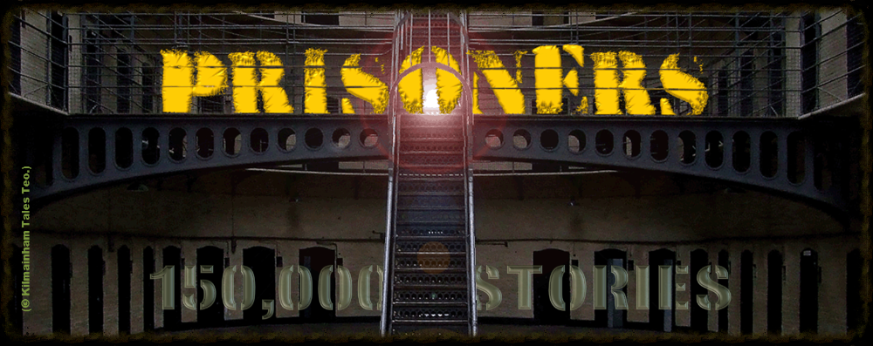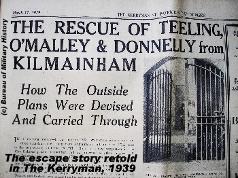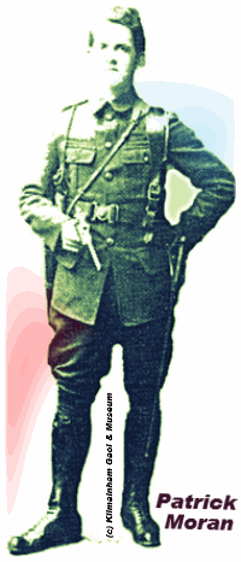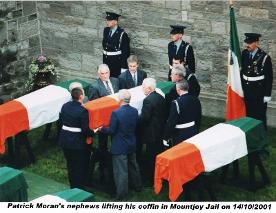
Patrick (Paddy) Moran
- hanged for a crime he didn't commit in 1921

Simon Donnelly had only been in the prison for 4 days, but he was well known to the authorities and was on a list of persons suspected of murdering police and was sure to be convicted, so it was deemed necessary to get him out of Gaol quickly.

Ernie O’Malley was incarcerated under the name Bernard Stewart, and though that name meant nothing to the authorities, O’Malley was such an important IRA organiser that Collins wanted him out before his true identity was discovered.

Frank Teeling was captured on 21 November 1920, Bloody Sunday, when he tried to scale a wall at the back of 22 Mount Street. He had been part of the Squad which was sent there to kill Lt H.R. Angliss (generally known as, and referred to in most books as, ‘Patrick McMahon’). Angliss was one of the men recalled from Russia to organize the intelligence group in Dublin. Lt ‘Peel’ escaped by piling all the furniture against the door.

Patrick (Paddy) Moran was also in the prison, and on Collins’ list of men to escape, but he did not take the opportunity.
Moran, a draper, was arrested in the shop in Blackrock where he worked on 26 November, just 5 days after Bloody Sunday. He was first taken to Arbour Hill prison where he was identified by Major Carew who lived at 28 Upper Mount Street.
Two other soldiers, Private Snelling and Private Lawrence (Carew’s batman) also identified Moran as having been in the party that raided 38 Upper Mount Street on Bloody Sunday

In the identification parade, Moran was the only clean-shaven man, and though he was sent to Kilmainham Gaol after the parade, a guard at Arbour Hill told him that there was a doubt in his identification and that he was not going for trial, but for another identification.
Moran’s solicitor, Michael Noyk, challenged the identification, but Moran was sent to Kilmainham to await trial, which was held on 15 February 1921.
Five witnesses testified against Moran, and he and Noyk pointed out the inconsistencies in all their testimony.
Moran also presented alibi testimony indicating he was in Blackrock at 8.00 am Mass, and several witnesses indicated they saw him there and talking to others after Mass. The house keeper where Moran lived testified that he came into the kitchen there shortly after 9.00 and asked if breakfast was ready.
The tram conductor in Blackrock testified that he saw Moran board his tram, and the first tram left Blackrock that morning at 9.30.
Moran was so convinced that his witnesses, his alibi, and the inconsistencies in the testimony of the identifying British soldiers would exonerate him that he chose not to escape with the others earlier in February.
That escape was very well planned, and the three men got away cleanly. Some claim a rope ladder was smuggled to the men, but it was a bolt cutter smuggled into the Gaol that ultimately released the escapees. Two British soldiers, Privates Holland and Roper smuggled the cutter into the Gaol, and the three men walked out through a disused side gate, with tram money in their pockets that had been smuggled into them by Desmond Fitzgerald and Sean Keating the previous weekend.
Moran, so confident in his defence, and trusting ‘in English justice’ as he wrote, did not want to jeopardise his witnesses and stayed behind. The others pleaded for him to escape, but he said he would not because he would not betray those who placed him in Blackrock, at his home or at Mass that morning. Paddy also felt that if escaped he would have to go ‘on the run’ and would be useless to the Volunteers. He later wrote his sister ‘I need not have been there to stand my trial if I did not think I would be all right’.
But Moran’s defence, and his witnesses, were a sham. Though Moran was not at 38 Upper Mount Street that morning, he was the leader of the squad in the Gresham Hotel.
In the Gresham Cpt. Patrick MacCormack in Room 22 (the IRA/Volunteers had asked for
Room 24) was killed by mistake. Hugh Callaghan was the doorman who led the IRA to the rooms, and he mistakenly took them to Room 22 instead of Room 24. MacCormack was really a member of the Royal Medical (Veterinary) Corps. Also killed was L.E. Wilde (Room 14) who had no connection with the Army or Intelligence.
The tram conductor in Blackrock testified that he saw Moran board his tram, and the first tram left Blackrock that morning at 9.30.
Moran was so convinced that his witnesses, his alibi, and the inconsistencies in the testimony of the identifying British soldiers would exonerate him that he chose not to escape with the others earlier in February.
That escape was very well planned, and the three men got away cleanly. Some claim a rope ladder was smuggled to the men, but it was a bolt cutter that ultimately released the escapees. Two British soldiers, Privates Holland and Roper, smuggled the cutter into the Gaol, and the three prisoners walked out through a disused side gate, with tram money in their pockets that had been given them by Desmond Fitzgerald.
Moran, so confident in his defence, and trusting ‘in English justice’ as he wrote, did not want to jeopardise his witnesses and stayed behind. The others pleaded for him to escape, but he said he would not because he would not betray those who placed him in Blackrock, at his home or at Mass that morning. Paddy also felt that if escaped he would have to go ‘on the run’ and would be useless to the Volunteers. He later wrote his sister ‘I need not have been there to stand my trial if I did not think I would be all right’.
But Moran’s defence, and his witnesses, were a sham.
Though Moran was not at 38 Upper Mount Street that morning, he was the leader of the squad in the Gresham Hotel. In the Gresham Cpt. Patrick MacCormack in Room 22 (the IRA/Volunteers had asked for Room 24) was killed by mistake. Hugh Callaghan was the doorman who led the IRA to the rooms, and he mistakenly took them to Room 22 instead of Room 24. MacCormack was really a member of the Royal Medical (Veterinary) Corps. Also killed was L.E. Wilde (Room 14) who had no connection with the Army or Intelligence.
Moran was convicted at his trial, was transferred to Mountjoy Prison and was hanged on 14 March 1921 for his ‘participation’ in the Bloody Sunday killings. He was buried in the Prison yard in an unmarked grave in unconsecrated ground. He had been tried, convicted and hanged for the wrong crime.

On October 14, 2001, Moran and nine others executed during the War of Independence were disinterred, afforded full state honours with a private service at Mountjoy for their families and, after a requiem Mass at the Pro Cathedral and a procession through Dublin, were re-interred in a special ceremony in Glasnevin Cemetery.
Patrick (Paddy) Moran and the others finally rest in peace.
Joe Connell
Joe has had a lifelong interest in Irish history with particular emphasis on the period around 1913 (the Lockout), 1916 (the Easter Rising) and on through 1924 and the ending of the Irish Civil War.
A lawyer and former instructor in the Californian Community College system, he spends his summers in Dublin, where he guides visitors on the 1916 Rebellion Walking Tour.